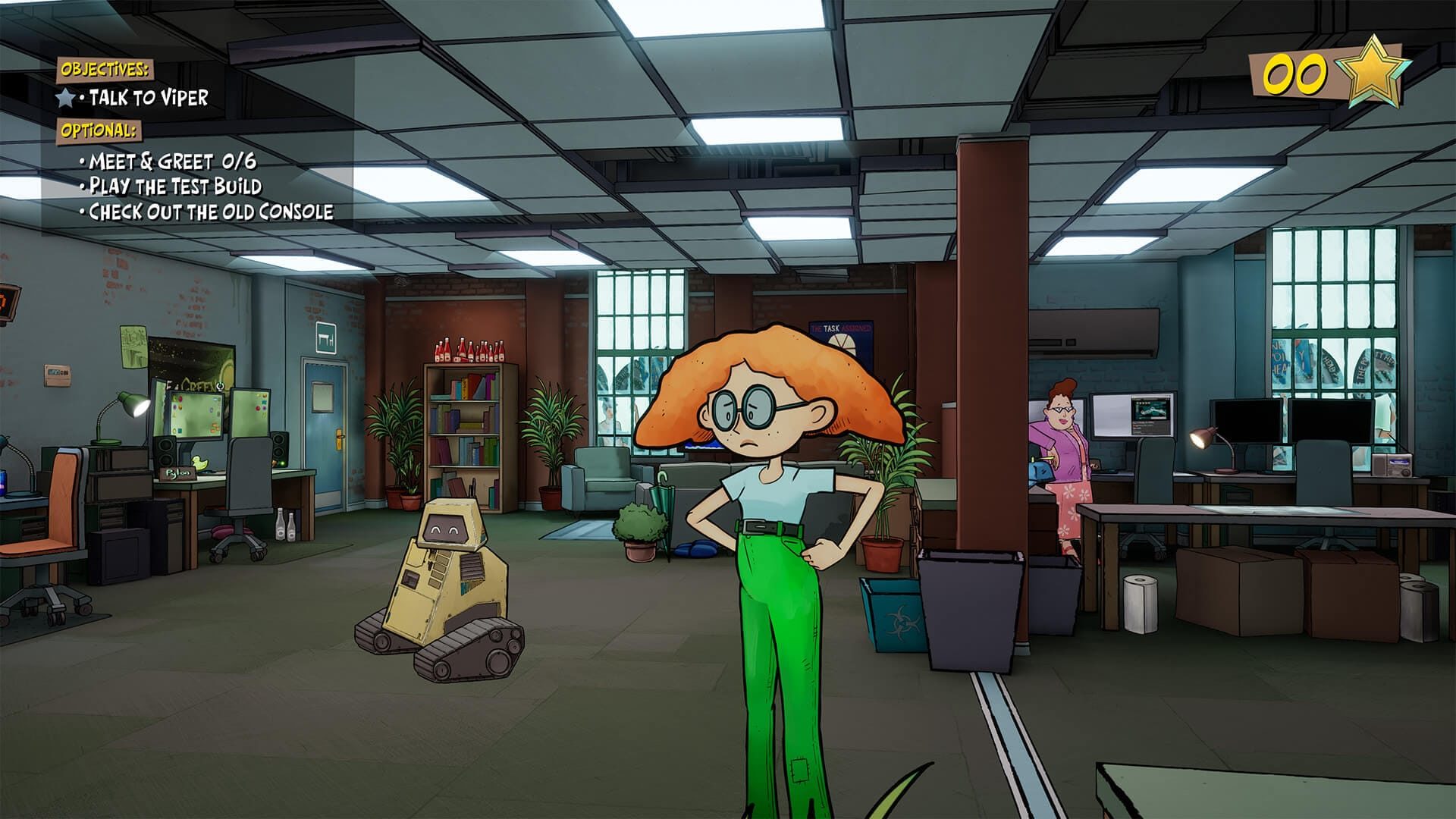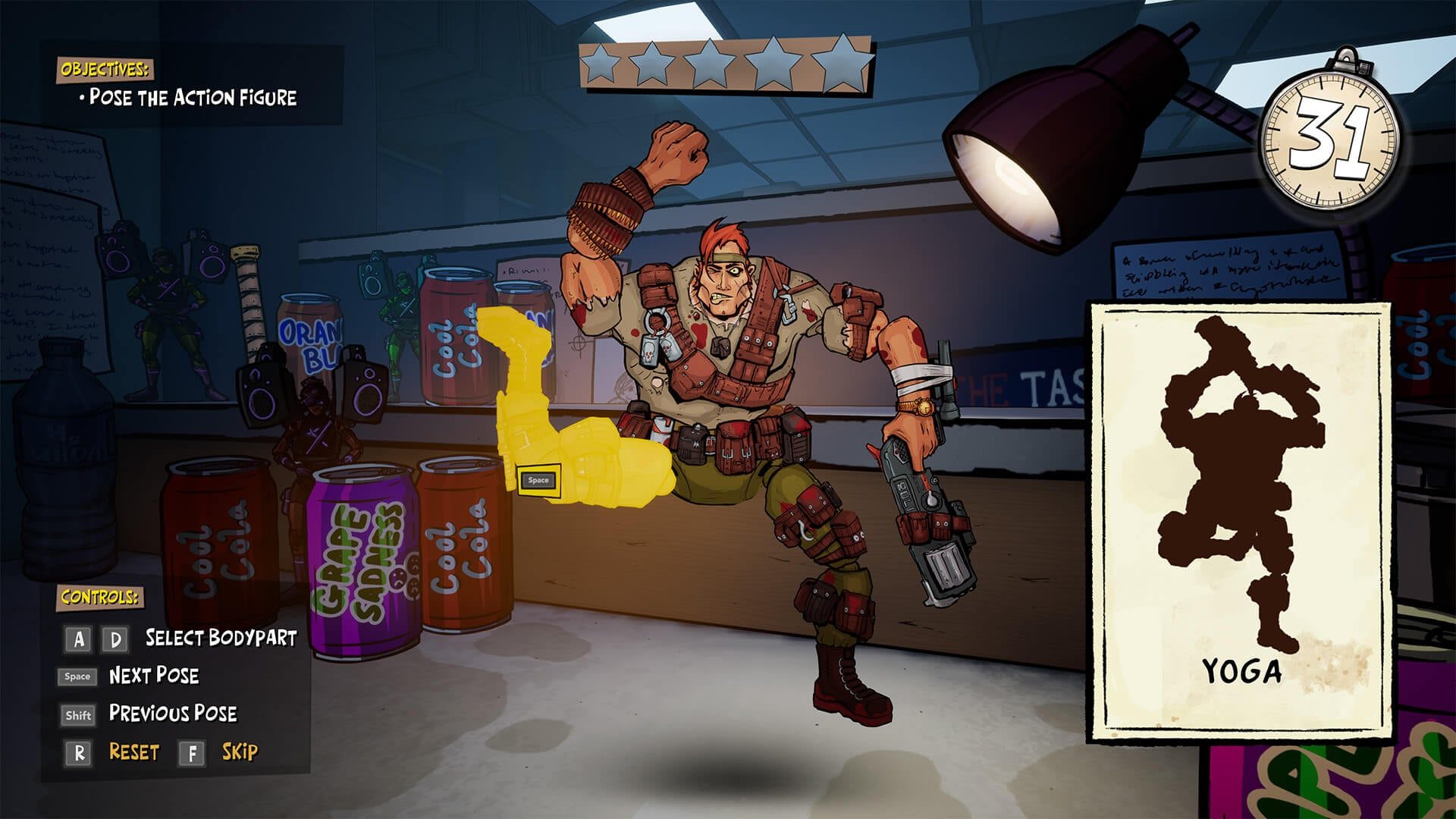I never really used the phrase “inside baseball” until I started working at EGM. Early on, one of my coworkers said that a review I was working on was “too inside baseball” by writing about the actual process of reviewing the game, instead of just reviewing the game itself. In other words, no one really cares what goes into writing a game review; they just want to read an opinion about the game and see a score. Fair enough.
But sometimes there’s a game (I write, as I stare wistfully towards the horizon), sometimes there’s a game that I have no idea how to review without getting inside baseball with it. Terrible Posture Games’ 3 Out of 10: Season One is one of those games.
3 Out of 10: Season One, which is launching for Nintendo Switch on March 3rd, is posited as a “playable sitcom” that consists of five half-hour episodes. Following the misadventures of the developers working at Shovelworks Studios and their goal for making a game that reviews better than 3 out of 10, each episode alternates between extended dialogue-driven, mostly static cutscenes and brief minigames that stand in for the more action-heavy moments in a show.

I know that alternating between cutscenes and gameplay sounds like pretty much every other game with a narrative, but to its credit, 3 Out of 10 does certain things that do make it feel like a sitcom. Most obvious is the length of each episode, which clocks in at about 30 minutes, depending on how long you play each minigame. The style of writing, while not always (or ever) laugh-out-loud funny, is snappy and over-the-top, servicing a story that doesn’t take itself too seriously and mostly exists to parody the world of game development.
Though 3 Out of 10 does manage to figure out how to translate that sitcom structure into an interactive format, and it has a ton of great ideas, it doesn’t really manage to bring all its ideas together to create a fun experience.
And here’s where I’m probably going to get a little too inside baseball. You see, I really didn’t need to review 3 Out of 10. No one assigned it to me, but Mollie posted about it in our work Slack and said she thought it “sounds interesting.” I said I was curious to try it, and asked for a review copy. Then I played it, and it did so many things wrong.
Normally, if a game is “bad,” I don’t have any problem giving it a low score. Most games I review are games that I was assigned to review and are backed by billion-dollar corporations with plenty of marketing and manufactured hype to get them on people’s hard drives. But when I purposefully seek a game out, a game that seemed perfectly fine with minding its own business and finding an audience, a game that’s made by a small studio and a handful of developers, giving that game a bad score just feels like bullying.

But that isn’t the only consideration when scoring a game like 3 Out of 10, because I sort of ended up… liking it, thanks to a series of smaller but significant design choices, seemingly inspired by the UX of streaming services like Netflix that puts the control in the users’ hands. The ability to skip cutscenes is nothing new, but being able to rewind and go back to previous cutscenes is something that I can’t believe I haven’t experienced in another game.
It feels revolutionary, and raises more questions about the kinds of general assumptions that go into triple-A story-driven game design. Why can’t I, for instance, play cutscenes at 1.25x speed? Why can’t I fast-forward or rewind within a cutscene, instead of completely skipping entire minutes? These seem like obvious choices to offer players, but most games don’t even consider giving players control over these aspects of their experiences.
Even more revolutionary is the ability to simply skip minigames if you don’t want to play them and just want to get back to the story. Part of why this works for 3 Out of 10 is that every minigame is different, so skipping gameplay doesn’t potentially disrupt the kinds of teachable moments that good games build upon sequentially. But I would honestly love it if, once again, more games gave players the option to just skip gameplay moments that they find annoying, unfun, or frustrating. Maybe that’s a sacrilegious statement, but after playing games for more than three decades, well, sometimes I’m just over it.
The issue is that 3 Out of 10 letting you skip minigames stands out as a positive choice because most of the minigames feel truly bad to play. Beat ’em up minigames are ruined by the fact that enemy attacks have one frame of animation for you to react by dodging or blocking them. Foam bullets in a “cover shooter” minigame will make contact with the target only arbitrarily. By making every minigame completely different, 3 Out of 10 doesn’t land on any consistent design decisions and half of them end up running the gamut from frustrating to absolutely miserable.

3 Out of 10’s other major issue is that it’s just not that funny. Part of the problem is that the jokes are always the same. One character says something wacky, and then the “reasonable” character reacts to it. Bits don’t necessarily build; they fizzle.
The writing also suffers from being too inside baseball. Most of the jokes are about game development itself, and not so much about the games. As someone who writes about games for a living, I felt at least versed enough in how studios operate to get why certain gags should be funny, but I still found it hard to connect to them, seeing as I’ve never worked as a developer. The writing picks up in the last episode, with an amusing sequence about characters glitching out that is relatable to anyone who has played pretty much any 3D video game, but the season ends just as it starts to get interesting.
The animation is also distracting. Terrible Posture Games mixes 2D illustrated characters with 3D environments in a way that looks great, but the actual animation results in a lot of elbows and joints clipping through other parts of the body. Most people might not notice, and it’s probably down to how they animated 2D characters in Unreal Engine, but I would like to have seen more bespoke animations, rather than relying on digital puppetry and character rigs.

Really, though, 3 Out of 10’s biggest sin is that, when it comes to the actual “sitcom” parts of this “playable sitcom,” players basically have no influence on what happens. Most narrative games that let players make decisions to drive the story are high-stakes dramas. But if something is a playable sitcom, it seems strange that I can’t choose what the characters do or, especially, what jokes they make. Instead, it just seems like another game, albeit with a slightly shorter runtime and a slightly more humorous tone.
But—ironically, given its title—I don’t want to give this game a bad score. Assigning a score so that it can be put up on a review aggregate site, where the experiences of games are flattened into generic numerals and small indie games are compared to games that cost hundreds of millions of dollars to develop and have less original ideas, just seems mean-spirited, especially because I find the game admirable in many ways. In my own efforts at independent animation, I’ve learned how much work goes into even the simplest artistic endeavors, let alone the complex process of developing a video game. What if some schmuck from a website with a much larger audience decided to pan my work out of nowhere? I spend most of my free time trying to find ways to get my stuff in front of an audience hoping that someone will see the small nugget of promise in what I’m doing and give me a shot. The least I can do is offer that same courtesy to 3 Out of 10. At least it lets me skip what I don’t like, and that’s more than I can say for pretty much every other game.
Images: 3 Out of 10, Terrible Posture Games

Michael Goroff has written and edited for EGM since 2017. You can follow him on Twitter @gogogoroff.